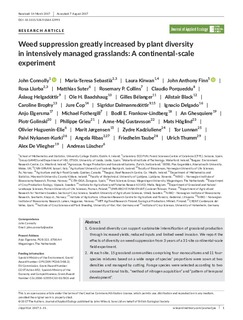| dc.contributor.author | Connolly, John | |
| dc.contributor.author | Sebastià, Maria-Teresa | |
| dc.contributor.author | Kirwan, Laura | |
| dc.contributor.author | Finn, John Anthony | |
| dc.contributor.author | Llurba, Rosa | |
| dc.contributor.author | Suter, Matthias | |
| dc.contributor.author | Collins, Rosemary P. | |
| dc.contributor.author | Porqueddu, Claudio | |
| dc.contributor.author | Helgadóttir, Áslaug | |
| dc.contributor.author | Baadshaug, Ole Hans | |
| dc.contributor.author | Bélanger, Gilles | |
| dc.contributor.author | Black, Alistair | |
| dc.contributor.author | Brophy, Caroline | |
| dc.contributor.author | Čop, Jure | |
| dc.contributor.author | Dalmannsdottir, Sigridur | |
| dc.contributor.author | Ignacio, Delgado | |
| dc.contributor.author | Elgersma, Anjo | |
| dc.contributor.author | Fothergill, Michael | |
| dc.contributor.author | Frankow-Lindberg, Bodil E. | |
| dc.contributor.author | An, Ghesquiere | |
| dc.contributor.author | Piotr, Golinski | |
| dc.contributor.author | Grieu, Philippe | |
| dc.contributor.author | Anne-Maj, Gustavsson | |
| dc.contributor.author | Höglind, Mats | |
| dc.contributor.author | Olivier, Huguenin-Elie | |
| dc.contributor.author | Jørgensen, Marit | |
| dc.contributor.author | Kadziuliene, Zydre | |
| dc.contributor.author | Lunnan, Tor | |
| dc.contributor.author | Nykanen-Kurki, Paivi | |
| dc.contributor.author | Ribas, Angela | |
| dc.contributor.author | Taube, Friedhelm | |
| dc.contributor.author | Thumm, Ulrich | |
| dc.contributor.author | De Vliegher, Alex | |
| dc.contributor.author | Lüscher, Andreas | |
| dc.date.accessioned | 2018-04-10T11:34:51Z | |
| dc.date.available | 2018-04-10T11:34:51Z | |
| dc.date.created | 2017-11-23T18:39:17Z | |
| dc.date.issued | 2018-03 | |
| dc.identifier.citation | Journal of Applied Ecology. 2017, . | nb_NO |
| dc.identifier.issn | 0021-8901 | |
| dc.identifier.uri | http://hdl.handle.net/11250/2493425 | |
| dc.description.abstract | 1. Grassland diversity can support sustainable intensification of grassland production through increased yields, reduced inputs and limited weed invasion. We report the effects of diversity on weed suppression from 3 years of a 31-site continental-scale field experiment. 2. At each site, 15 grassland communities comprising four monocultures and 11 four-species mixtures based on a wide range of species' proportions were sown at two densities and managed by cutting. Forage species were selected according to two crossed functional traits, “method of nitrogen acquisition” and “pattern of temporal development”. 3. Across sites, years and sown densities, annual weed biomass in mixtures and monocultures was 0.5 and 2.0 t DM ha−1 (7% and 33% of total biomass respectively). Over 95% of mixtures had weed biomass lower than the average of monocultures, and in two-thirds of cases, lower than in the most suppressive monoculture (transgressive suppression). Suppression was significantly transgressive for 58% of site-years. Transgressive suppression by mixtures was maintained across years, independent of site productivity. 4. Based on models, average weed biomass in mixture over the whole experiment was 52% less (95% confidence interval: 30%–75%) than in the most suppressive monoculture. Transgressive suppression of weed biomass was significant at each year across all mixtures and for each mixture. 5. Weed biomass was consistently low across all mixtures and years and was in some cases significantly but not largely different from that in the equiproportional mixture. The average variability (standard deviation) of annual weed biomass within a site was much lower for mixtures (0.42) than for monocultures (1.77). 6. Synthesis and applications. Weed invasion can be diminished through a combination of forage species selected for complementarity and persistence traits in systems designed to reduce reliance on fertiliser nitrogen. In this study, effects of diversity on weed suppression were consistently strong across mixtures varying widely in species' proportions and over time. The level of weed biomass did not vary greatly across mixtures varying widely in proportions of sown species. These diversity benefits in intensively managed grasslands are relevant for the sustainable intensification of agriculture and, importantly, are achievable through practical farm-scale actions. | nb_NO |
| dc.language.iso | eng | nb_NO |
| dc.publisher | John Wiley and Sons Inc. | nb_NO |
| dc.rights | Navngivelse 4.0 Internasjonal | * |
| dc.rights.uri | http://creativecommons.org/licenses/by/4.0/deed.no | * |
| dc.subject | agro-ecology | nb_NO |
| dc.subject | evenness | nb_NO |
| dc.subject | forage swards | nb_NO |
| dc.subject | functional diversity | nb_NO |
| dc.subject | generalised diversity-interactions | nb_NO |
| dc.subject | legume–grass | nb_NO |
| dc.subject | nitrogen acquisition | nb_NO |
| dc.subject | sustainable agriculture | nb_NO |
| dc.subject | temporal development | nb_NO |
| dc.subject | transgressive weed suppression | nb_NO |
| dc.title | Weed suppression greatly increased by plant diversity in intensively managed grasslands: A continental-scale experiment | nb_NO |
| dc.type | Journal article | nb_NO |
| dc.type | Peer reviewed | nb_NO |
| dc.description.version | publishedVersion | nb_NO |
| dc.rights.holder | © 2017 The Authors. Journal of Applied Ecology published by John Wiley & Sons Ltd on behalf of British Ecological Society | nb_NO |
| dc.source.pagenumber | 11 | nb_NO |
| dc.source.volume | 55 | nb_NO |
| dc.source.journal | Journal of Applied Ecology | nb_NO |
| dc.source.issue | 2 | nb_NO |
| dc.identifier.doi | 10.1111/1365-2664.12991 | |
| dc.identifier.cristin | 1517916 | |
| dc.relation.project | Internasjonale institusjoner Science Found. Ireland: grant number 09/RFP/EOB2546 | nb_NO |
| dc.relation.project | EC/FP7/266018 | nb_NO |
| dc.relation.project | EC/COST/Action 852 | nb_NO |
| cristin.ispublished | true | |
| cristin.fulltext | original | |
| cristin.qualitycode | 2 | |

